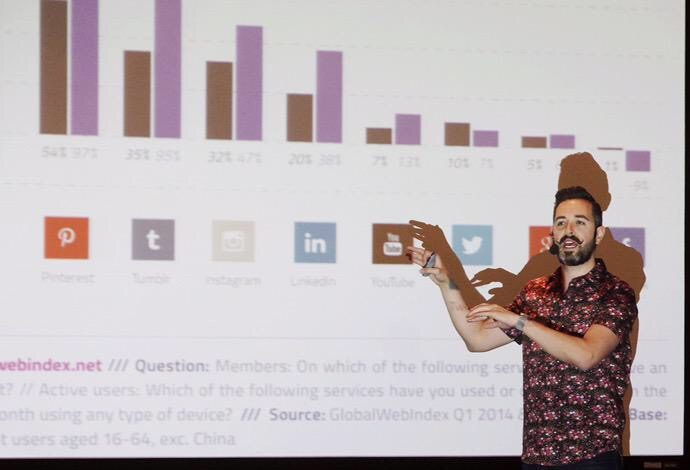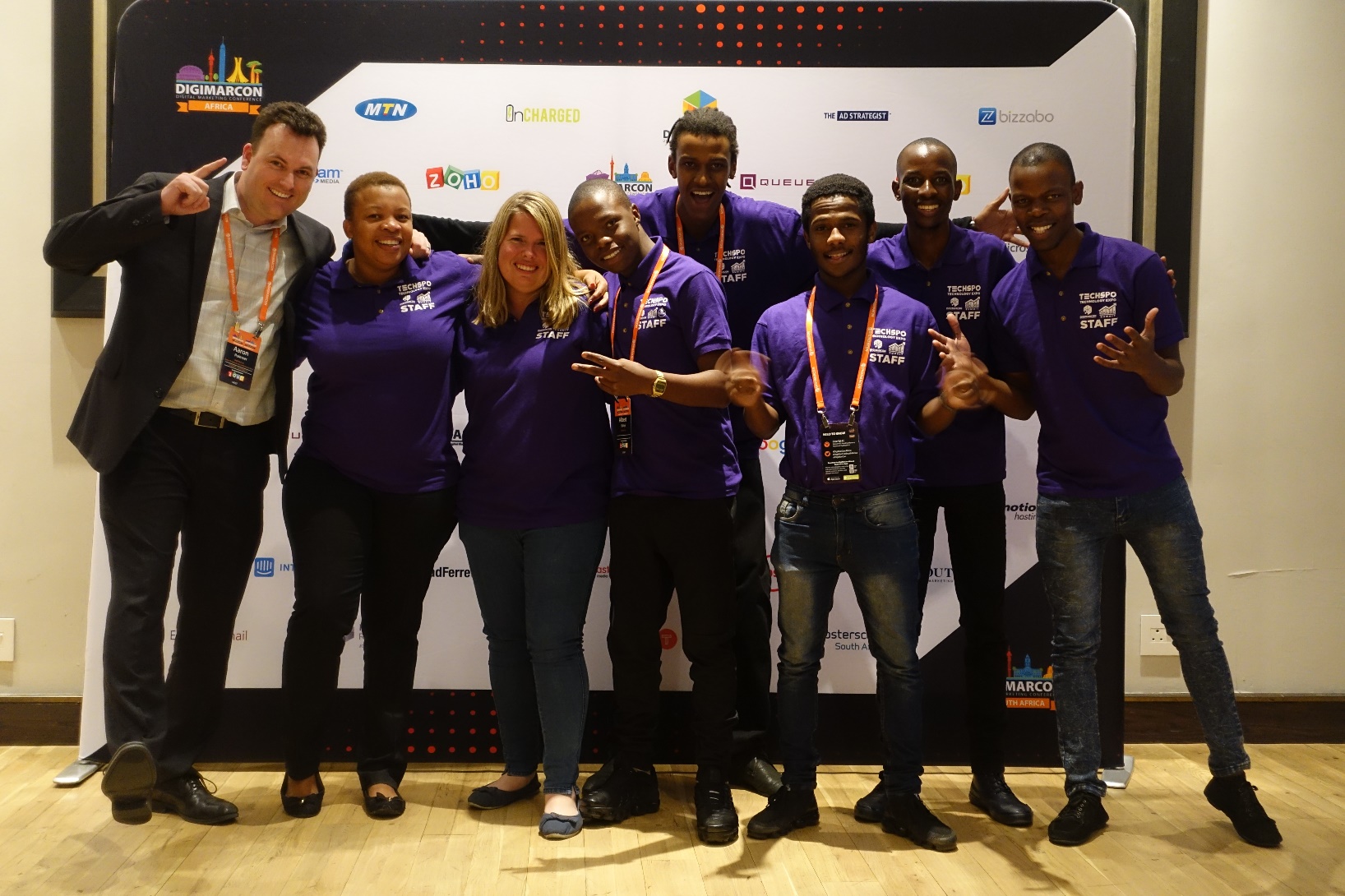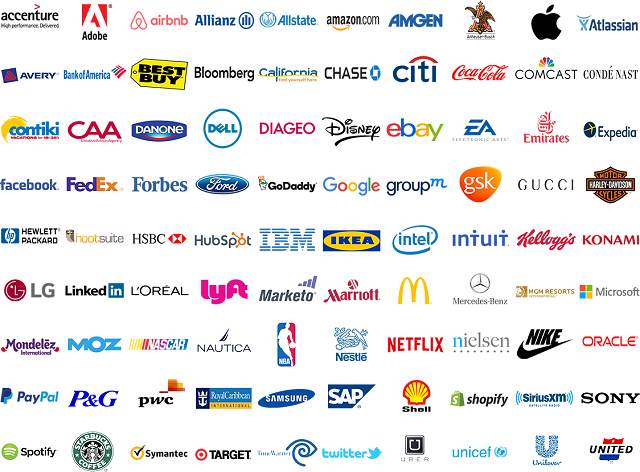Posts Tagged "Online Branding"
Articles
- Best Marketing Conference Sponsorship
- What Does it Mean to Be an Exhibitor at a Conference?
- What Is the Biggest Social Media Conference?
- What Is an Innovation Conference?
- What Is a Typical B2B Event?
- What Are the Cloud Technology Events in 2025?
- Marketing Event Volunteer Opportunities: A Comprehensive Guide
- Digital Marketing Event Volunteer Opportunities Near Me
- What Does a Volunteer Do at a Conference?
- Is DigiMarCon Worth It?
- Is DigiMarCon Good?
- What is the Biggest Marketing Forum?
- What are Digital Marketing Conferences?
- Marketing Conference Exhibiting: Your Guide to Success
- Digital Summit Comparison: A Closer Look at DigiMarCon
- Digital Marketing Conference
- Digital Marketing Events: Your Guide to Success in 2025
- Marketing Conferences: Unlocking Your Business Potential in 2025
- What Is The Future of Digital Marketing in 2030?
- B2B Event Marketing Strategy: Unlocking Success For Your Business
- Why B2B Event Marketing?
- What Should a B2B Marketing Strategy Include?
- Top Marketing Conferences for 2025
- What Is the Future of Marketing in 2025?
Digital Marketing Conferences
- NORTH AMERICA
- DigiMarCon Cruise
(New Orleans, LA, USA) - DigiMarCon West
(Los Angeles, CA, USA) - DigiMarCon Northwest
(Seattle, WA, USA) - DigiMarCon Canada West
(Vancouver, BC, USA) - DigiMarCon Canada
(Toronto, ON, Canada) - DigiMarCon Canada East
(Montreal, QC, Canada) - DigiMarCon Florida
(Orlando, FL, USA) - DigiMarCon Gulf Coast
(Houston, TX, USA) - DigiMarCon Southern California
(San Diego, CA, USA) - DigiMarCon Midwest
(Chicago, IL, USA) - DigiMarCon Mid-South
(Nashville, TN, USA) - DigiMarCon Great Lakes
(Detroit, MI, USA) - DigiMarCon North
(Minneapolis, MN, USA) - DigiMarCon Central
(Kansas City, MO, USA) - DigiMarCon Texas
(Dallas, TX, USA) - DigiMarCon New England
(Boston, MA, USA) - DigiMarCon Mid-Atlantic
(Philadelphia, PA, USA) - DigiMarCon South Florida
(Miami, FL, USA) - DigiMarCon Southeast
(Atlanta, GA, USA) - DigiMarCon Central Florida
(Tampa, FL, USA) - DigiMarCon East
(New York, NY, USA) - DigiMarCon South Atlantic
(Charlotte, NC, USA) - DigiMarCon America
(Washington, D.C. USA) - DigiMarCon Northern California
(San Francisco, CA, USA) - DigiMarCon Rocky Mountains
(Denver, CO, USA) - DigiMarCon South
(San Antonio, TX, USA) - DigiMarCon Silicon Valley
(San Jose, CA, USA) - DigiMarCon Orange County
(Anaheim, CA, USA) - DigiMarCon Southwest
(Phoenix, AZ, USA) - DigiMarCon World
(Las Vegas, NV, USA)
- DigiMarCon Cruise
- LATIN AMERICA
- EUROPE
- MIDDLE EAST
- AFRICA
- ASIA PACIFIC
- DigiMarCon Hawaii & Pacific
(Honolulu, HI, USA) - DigiMarCon Asia & Japan
(Tokyo, Japan) - DigiMarCon New Zealand
(Auckland, New Zealand) - DigiMarCon Australia
(Sydney, Australia) - DigiMarCon Oceania
(Melbourne, Australia) - DigiMarCon Southeast Asia
(Singapore) - DigiMarCon India
(New Delhi, India) - DigiMarCon North Asia & China
(Shanghai, China)
- DigiMarCon Hawaii & Pacific
- VIRTUAL
Digital Marketing Blog
- What Makes DigiMarCon Stand Out (And Is It Worth It?) October 30, 2025
- Is DigiMarCon Worth Attending? A Complete Breakdown October 29, 2025
- DigiMarCon for Startups: Why Founders Shouldn’t Miss It October 29, 2025
- DigiMarCon Recap: What Went Down and What’s Next October 29, 2025

































Content Marketing Trends Shaping the Future
The digital world is always changing, and content marketing is leading this shift. Businesses must keep up to stay ahead. It’s important to know the trends that are shaping the industry.
The future of digital marketing relies on being able to adapt and innovate in content strategies. This article will look at the main areas that will lead to success in the digital world.
Key Takeaways
The Evolving Landscape of Content Marketing in 2023
In 2023, content marketing is changing fast. Brands are facing new challenges and finding new ways to connect with people. The digital world keeps changing, thanks to new trends and tech.
Key Statistics and ROI Benchmarks
Studies show content marketing is key, with 70% of marketers using it. It can bring big returns, with some seeing a return of up to $6 for every $1 spent. Here are some important stats:
Post-Pandemic Shifts in Content Consumption
The pandemic changed how we consume content. Now, people want more video content and interactive media. This change has led to:
Digital Fatigue and Quality-Over-Quantity Approach
With so much content out there, digital fatigue is a big issue. To fight it, brands are focusing on quality over quantity. They’re making content that’s engaging and valuable. This means:
Content Marketing Trends That Will Define the Next Decade
The next decade will mix technology, creativity, and focus on the customer. Brands will need to keep up with new trends in content marketing. This will help them succeed in the changing digital world.
The Convergence of Content and Customer Experience
Content and customer experience are getting closer together. Brands aim to create deep, engaging experiences for customers. They want to offer personalized and relevant content that speaks to their audience.
Cross-Channel Content Integration
It’s important for brands to have a consistent message across all platforms. They need a unified content strategy that matches their marketing goals.
Omnichannel Content Distribution Strategies
Brands should use omnichannel strategies to reach people on social media, email, and websites. This way, their content stays consistent and engaging everywhere.
To succeed, brands must keep up with social media marketing trends and content strategy updates. This will help them build a strong content marketing plan. Such a plan will boost engagement and sales.
AI and Machine Learning Revolutionizing Content Creation
AI and machine learning are changing content creation in big ways. They’re making it easier to come up with, make, and share content.
AI-Generated Content: Practical Applications
AI can now make all sorts of content, from news to ads. Tools like language generators can create top-notch content that people want to read.
Quality Control and Human Oversight
But, AI content needs to be checked for quality and fit. It’s important to make sure it meets brand standards and connects with readers. Human editors are key in making AI content better, adding feelings and depth that AI might miss.
Predictive Analytics for Content Performance
Predictive analytics use machine learning to guess how well content will do. By looking at past data and trends, these models can spot what content will likely hit the mark. This helps marketers make better choices.
As AI and machine learning get better, they’ll play an even bigger part in making content. By using these tools, content marketers can keep up with the latest trends and deliver content that really speaks to their audience.
Video Marketing: The Undisputed Content Champion
In the world of content marketing, video content shines brightly. Brands are using video marketing to grab their audience’s attention. It’s a mix of engagement, ease of access, and flexibility.
Short-Form Video Dominance Across Platforms
Short-form video content is everywhere and very effective. Platforms like TikTok, Instagram Reels, and YouTube Shorts are leading the way. They let brands share short, engaging videos with their audience.
Live Streaming and Interactive Video Engagement
Live streaming has changed how brands talk to their audience. It offers real-time interaction, creating a stronger bond between the brand and its viewers. Interactive elements like live Q&As, polls, and chat functionality make the experience more engaging and memorable.
Advanced Video SEO Techniques for Higher Visibility
To make video content work harder, it needs to be optimized for search engines. Using relevant keywords in video titles, descriptions, and tags is key. Also, optimizing video thumbnails can help more people click on your videos. Hosting videos on your own site can also boost your site’s SEO, bringing in more traffic and engagement.
By using these video marketing strategies, brands can improve their online presence. They can connect better with their audience and achieve real results online.
Voice Search and Audio Content: The Listening Revolution
Voice technology is changing how we market. Smart speakers and voice assistants are making our world more auditory. This shift is changing how we interact with brands.
Strategic Podcast Marketing for Brand Authority
Podcast marketing is a strong way to build brand authority. By making engaging content, businesses can show they know their stuff. Here are some key strategies:
Voice Search Optimization for Featured Snippets
Optimizing for voice search is key for featured snippets. These snippets are often read aloud by voice assistants. To increase your chances:
Conversational Keywords and Natural Language Processing
Using conversational keywords is essential for voice search. By using natural language processing (NLP), businesses can understand and meet voice queries better. This means:
Mobile-First Content Strategies for the On-the-Go Consumer
In today’s world, focusing on mobile content is key to grabbing the attention of always-connected people. With mobiles leading the way in how we use the internet, companies need to make their content easy to use on phones. They must also think about what people want when they’re on the move.
Mobile UX and Micro-Moment Content Delivery
Improving how mobile users experience your content is essential. Micro-moment content delivery gives users quick, useful info when they need it. This approach boosts engagement and helps turn visitors into customers.
App-Based Content Ecosystems
App-based content systems give users a personalized and immersive experience. By using in-app content, companies can build stronger bonds with their audience. This leads to more loyalty and keeps users coming back.
Push Notifications and In-App Content Strategies
Push notifications can greatly increase user interaction by sending timely, relevant content. When paired with in-app content, they make the app experience better. This encourages users to stay engaged with the app.
By using these mobile-first strategies, businesses can connect better with their always-on-the-go audience. This approach is not just good; it’s necessary to stay ahead in the digital world.
Social Media Content Trends Reshaping Brand Communication
The way brands talk to their audience is changing fast. This is thanks to new trends in social media. Brands must keep up with these changes to connect with their followers.
Platform-Specific Content Optimization Techniques
Brands must make their content fit each social media site’s style. For example, Instagram loves pictures, so brands should post high-quality images. Twitter is all about quick updates, so brands should keep their posts short and timely.
Social Commerce: Turning Content into Conversion Points
Social media is now a place where you can buy things right away. Social commerce lets brands turn their posts into places where you can buy. This makes shopping easy and fun for customers.
Building Engaged Communities Through Value-Driven Content
Marketers want to build strong communities around their brands. They do this by creating value-driven content. This means making content that teaches, entertains, or inspires people.
By keeping up with social media trends, brands can change how they talk to their audience. This helps them connect better and achieve their goals.
The Evolution of Influencer Marketing Beyond Promotion
Influencer marketing is changing, focusing more on being real and building strong partnerships. Brands want to connect with people in a deeper way. So, they’re moving away from just promoting products.
Micro and Nano Influencers: Authenticity at Scale
Micro and nano influencers are key now. They offer realness on a big scale. With smaller, but very engaged followers, they can promote brands in a trusted way.
Co-Creation Strategies for Long-Term Influencer Partnerships
Co-creation is a great way to build lasting partnerships with influencers. It means working together to make content. This way, brands can create something that really speaks to their audience.
Performance Metrics for Influencer Content
Brands need to measure how well their influencer campaigns do. They look at things like how many people engage, how many see the content, and how many buy something. This helps them make their campaigns better over time.
By following these trends and strategies, brands can do more than just promote. They can build real connections with people and gain their loyalty for the long haul.
User-Generated Content: Harnessing the Power of Your Community
In today’s world, user-generated content is key in content marketing. It helps brands build trust and authenticity. UGC is content made and shared by people, not the brand itself. It’s a strong tool for boosting engagement and loyalty.
Strategic UGC Campaigns That Drive Engagement
Brands need to create smart UGC campaigns to get people involved. This can be through contests, challenges, or asking customers to share their brand experiences. For example, a brand might start a social media contest. They ask followers to post photos or videos of how they use the brand’s product or service.
UGC Curation and Rights Management
As UGC campaigns grow, managing the content is key. Brands need a clear plan for curating UGC, making sure it fits their brand values. Also, getting the right to use this content is essential. This means understanding copyright laws and getting consent from creators.
Incentivizing Quality User Contributions
To get better content, brands can offer rewards, recognition, or early access to new products. This makes contributors feel appreciated, building a loyal community. For instance, showing user-generated content on the brand’s official channels can encourage more people to share.
By using user-generated content and smart UGC campaigns, brands can tap into their community’s creativity. This drives engagement and helps build a more genuine brand image.
SEO Trends Transforming Content Discoverability
The digital world is always changing. SEO trends are now key to finding and using online content. As search engines get smarter, content marketers must keep up to stay seen and relevant.
E-A-T and Core Web Vitals Impact on Content Strategy
Google now values E-A-T (Expertise, Authoritativeness, Trustworthiness) and Core Web Vitals. To be found, content must be top-notch and show you know your stuff. Also, websites need to load fast, work well on phones, and be easy to get around.
Semantic Search and Topic Clusters
Semantic search changes how search engines see and rank content. Instead of just keywords, focus on topic clusters. This means grouping content around a main topic to show you know a lot about it.
Implementing Topic Clusters:
Technical SEO Considerations for Content Marketers
Technical SEO is still very important for getting content seen. Make sure your content can be found and understood by search engines. Work with your technical SEO team to make your website better for search engines.
Key Technical SEO Considerations:
Conclusion: Future-Proofing Your Content Marketing Strategy
Exploring the latest Content Marketing Trends shows us that staying ahead is complex. It involves using AI for content, focusing on video marketing, and optimizing for voice search. Businesses can then set themselves up for success.
To make your content marketing strategy future-proof, focus on Content strategy updates. Prioritize customer experience, adaptability, and innovation. This means using content across different channels, using content from users, and keeping up with SEO trends like E-A-T and Core Web Vitals.
By putting the customer first and staying flexible with new trends, marketers can create real engagement and sales. As the digital world keeps changing, success depends on always learning and updating your strategy.
FAQ
What are the key content marketing trends to watch in the next decade?
Content marketing will blend with customer experience. Cross-channel content will become more integrated. AI-generated content will also rise.
How is AI impacting content creation?
AI is changing content creation. It’s making AI-generated content, predictive analytics, and quality control easier. This helps marketers make better content faster.
What role does video marketing play in content strategy?
Video marketing is leading the way. Short-form videos, live streaming, and interactive videos are key. They boost engagement and conversions.
How can brands optimize for voice search and audio content?
To optimize for voice search, use conversational keywords and natural language. Strategic podcast marketing helps build brand authority and get featured snippets.
What are the best practices for mobile-first content strategies?
For mobile-first strategies, focus on mobile UX and micro-moment content. Use app-based content ecosystems to engage mobile users.
How can brands leverage user-generated content effectively?
Run strategic UGC campaigns and manage rights. Incentivize quality contributions to boost engagement and conversions.
What are the latest SEO trends impacting content discoverability?
New SEO trends include E-A-T and Core Web Vitals. Semantic search and topic clusters are also important. Technical SEO is crucial for content marketers.
How is influencer marketing evolving beyond promotion?
Influencer marketing is changing. It now uses micro and nano influencers, co-creation, and performance metrics. This aims for authenticity and long-term partnerships.
What are the benefits of social commerce in content marketing?
Social commerce turns content into sales points. It boosts revenue through platform-specific content and social media engagement.
Effective Social Media Marketing Strategies for Success
In today’s digital world, having a strong online presence is key for businesses to thrive. If you’re in digital marketing or leading a business, you know how vital it is to use online platforms to connect with your audience.
The digital marketing world is always changing. This article will cover the latest in online marketing, setting goals, and strategies that work. By the end, you’ll know how to improve your online presence and boost your business.
Key Takeaways
The Current Social Media Landscape
Understanding the fast-changing social media world is key. Marketers need to know about user trends and platform updates. This knowledge helps in creating effective online marketing plans.
Platform Demographics and User Behavior
Each social media site draws different people. For example, TikTok and Instagram are popular with the young. Meanwhile, LinkedIn is favored by professionals. Knowing this helps in targeting the right audience with digital ads.
Recent Algorithm Changes Affecting Marketing
Social media algorithms keep changing, affecting how we see content. New updates focus on user engagement and content relevance. Marketers must adjust their strategies to stay seen and reach their audience.
By keeping up with these updates, marketers can make their online marketing better. This leads to more effective digital ads.
Setting Clear Social Media Marketing Goals
Creating a strong social media marketing plan starts with clear goals. “You can’t manage what you don’t measure,” says Peter Drucker. This is especially true for social media marketing.
Defining SMART Objectives
Social media goals need to be SMART: Specific, Measurable, Achievable, Relevant, and Time-bound. For example, instead of saying “increase brand awareness,” aim to “boost Instagram followers by 20% in 6 months with targeted content and engagement.”
Aligning Social Media Goals with Business Outcomes
Social media goals must match the company’s bigger goals. This makes sure social media helps the business succeed. For example, if a company wants to sell more, its social media goals might be to get more website visitors or leads.
Benchmarking Against Competitors
Looking at what competitors do on social media is helpful. It shows what’s common and where you can stand out. By studying competitors, businesses can find new ways to be better.
With clear, aligned, and benchmarked goals, businesses can make their social media marketing stronger. This leads to better social media engagement strategies and Social Media Marketing Strategies.
Social Media Marketing Strategies That Drive Results
The secret to successful social media marketing is to use strategies that match your business goals. To see real results, focus on building a strong online presence that speaks to your audience.
Content-First Approach
Putting content first is key in social media marketing. High-quality, relevant content attracts and keeps your audience. Create a content plan that includes informative, entertaining, and engaging content for different audience segments.
Use various content types like videos, blog posts, and infographics to keep people interested. It’s also important to optimize content for different social media platforms. This means using each platform’s unique features and how users behave.
Community Building Tactics
Building and engaging with your community is crucial. This means creating a brand community by fostering interactions through comments, messages, and reviews. You can do this by hosting webinars, creating Facebook groups, and running contests.
To build a strong community, engage consistently and respond personally to your audience. This builds trust and loyalty, leading to more conversions and growth.
Conversion-Focused Strategies
Conversion-focused strategies aim to get specific actions from your audience. Create social media campaigns that meet your business goals, like generating leads, driving sales, or increasing website traffic. Use tactics like limited-time offers, exclusive deals, and ads to boost conversions.
To get the most conversions, track and analyze your social media performance. This helps you find what works and improve your strategies.
Platform-Specific Tactics for Maximum Impact
To make a big splash in social media, marketers need to use tactics made for each platform. Each platform has its own special chances and challenges. So, it’s key to have strategies that fit each one well.
Facebook Marketing Techniques
Facebook is still a top spot for marketers. It has a huge number of users and lots of ways to advertise. Good digital advertising techniques on Facebook include:
Instagram Growth Approaches
Instagram is all about pictures and videos. To grow on Instagram, you need:
LinkedIn for B2B Success
LinkedIn is perfect for B2B marketers. It’s all about connecting with professionals. Good strategies include:
TikTok and Short-Form Video Strategies
TikTok is all about short videos. To do well, you need:
Trending Audio Utilization
Using popular audio can really get people engaged on TikTok. Keep up with the latest trends and add them to your videos.
Hashtag Strategy for Discovery
Hashtags are key to getting found on TikTok, just like on Instagram. Find and use the right hashtags to make your content more visible.
By knowing and using these platform-specific tactics, marketers can boost their social media engagement strategies. This way, they can make a big impact on different platforms.
Content Creation Best Practices
Content creation is key in social media marketing. It drives engagement and conversions. Marketers need a strong content strategy that speaks to their audience.
Visual Content That Drives Engagement
Visual content grabs attention and boosts interaction. Using high-quality images, videos, and infographics can increase engagement. For example, tweets with images get 150% more retweets than those without.
Copywriting Formulas for Social Media
Good copywriting is vital for sharing your brand’s message. Using formulas like AIDA or PAS can make your social media posts effective. Make sure your message fits your audience’s needs for the best results.
User-Generated Content Implementation
User-generated content (UGC) is a treasure for social media marketers. It’s authentic and engaging. But, setting up UGC campaigns needs careful planning.
UGC Campaigns That Convert
To succeed with UGC, offer incentives for users to share their brand experiences. A contest or giveaway can spark user-generated content.
Legal Considerations for UGC
UGC campaigns come with legal hurdles. Brands must get the right permissions to use user content. Clear terms and conditions are crucial.
By following these content creation tips, businesses can boost their online presence. They can drive engagement and meet their marketing goals.
Building and Nurturing Your Community
Creating a loyal community around your brand is key to long-term success on social media. Marketers can do this by engaging with their audience and creating meaningful interactions. This way, they build a community that supports the brand and drives business outcomes.
Community Management Frameworks
Effective community management is essential for any successful social media strategy. To manage your community well, consider these frameworks:
Response Strategies for Comments and Messages
Responding to comments and messages is crucial for building trust and fostering engagement. Here are some strategies to consider:
Creating Interactive Experiences
Interactive experiences are vital for keeping your community engaged. Some effective techniques include:
By using these strategies, you can create a vibrant and engaged community. This community will support your brand’s marketing goals.
Paid Social Media Advertising Tactics
In the world of social media, paid ads help businesses shine. Marketers use various tactics to boost engagement, conversions, and revenue. This is key to success.
Ad Format Selection and Optimization
Choosing the right ad format is vital. Formats like images, videos, carousels, and stories each have their own strengths. Optimizing ad creative for these formats can greatly improve results. High-quality visuals and compelling copy can boost engagement.
Advanced Targeting and Retargeting Approaches
Advanced targeting lets advertisers reach specific audience segments. Retargeting campaigns target users who’ve shown interest but haven’t converted. These strategies make paid social media campaigns more effective.
Budget Allocation for Maximum ROI
Effective budget allocation is key for ROI in paid social media ads. It’s about setting the right budget and allocating it wisely. A/B testing helps find the best strategies.
A/B Testing Methodologies
A/B testing compares two ad versions to see which works better. This helps refine paid social media tactics, improving campaign results.
Scaling Successful Campaigns
Scaling successful campaigns can amplify their impact. This means increasing budget, expanding audience, or optimizing ads. Continuous monitoring ensures the campaign stays effective as it grows.
Leveraging Influencer Partnerships
Influencer marketing has become a key tool for brands to reach new people and gain trust on social media. By teaming up with influencers, brands can create content that truly connects with their audience.
Identifying Aligned Influencers for Your Brand
Finding the right influencers is key to successful influencer marketing. You need to look at their content, how engaged their followers are, and who they are talking to. This ensures they match your brand and audience.
Structuring Performance-Based Campaigns
Creating campaigns that focus on results is essential. Set clear goals, like increasing sales or engagement, and track how well they do. Use special links to see how your campaign is doing.
Measuring Influencer Marketing Impact
To see if influencer marketing is working, you need to track its results. Look at things like how many people are engaging, how many are buying, and how much money you’re making back.
Analytics and Performance Measurement
Understanding social media marketing success requires a deep look at analytics and performance. Businesses must track key performance indicators (KPIs) on various social media platforms. This helps measure their efforts’ success.
Essential Metrics to Track by Platform
Different social media platforms offer unique metrics for performance tracking. On Facebook, engagement metrics like likes, comments, and shares are key. Instagram focuses on story views and swipe-through rates for user interaction insights. LinkedIn’s click-through rates and post engagement are vital for B2B marketing success.
Attribution Modeling for Social Media
Attribution modeling is essential for understanding social media’s impact on business outcomes. It helps marketers see which social media interactions lead to conversions or sales. This way, they can better allocate resources and improve marketing strategies.
Turning Data into Strategic Decisions
The real value of analytics is in making data-driven decisions. By analyzing performance data, marketers can spot areas for improvement. They can then optimize content and advertising, leading to better business results. This involves regularly reviewing metrics, adjusting campaigns, and staying current with social media analytics trends.
By using these analytics and performance strategies, businesses can improve their social media marketing. They can enhance their online presence and achieve marketing goals more effectively.
Social Media Marketing Automation and Tools
Social media marketing tools have become key in today’s fast-paced world. They help businesses manage their online presence better. This makes their marketing efforts more efficient and effective.
Content Planning and Scheduling Platforms
Keeping a steady flow of content on social media is vital. Tools like Hootsuite and Buffer make this easier. They let marketers schedule posts for different times, saving time and effort.
Creative Asset Development Tools
Automation tools also play a big role in creating content. Canva and Adobe Creative Cloud offer easy-to-use design tools. They help marketers make professional-looking content without needing to be designers.
Key Features of Creative Asset Development Tools:
Analytics and Reporting Solutions
Measuring campaign success is crucial. Tools like Sprout Social and Google Analytics give valuable insights. They show how well content is doing and help make informed decisions.
Using these tools can save businesses a lot of time. It also helps them improve their content and understand their audience better. This approach is vital for staying ahead in the digital world.
Emerging Trends Shaping the Future of Social Media Marketing
Looking ahead, several trends are set to change social media marketing. The field is always evolving, thanks to new tech and how people use it. Marketers need to keep up with these changes to stay innovative in their social media marketing strategies.
AI and Machine Learning Applications
Artificial intelligence (AI) and machine learning are changing social media marketing. They make digital advertising techniques smarter, like predictive analytics and tailored content. With AI, marketers can make customer experiences better and campaigns more effective.
Social Commerce Evolution
Social commerce is growing fast, with shopping features now part of social media. This shift changes how people shop online, making it simpler to find and buy products right on social media.
Privacy Changes and Their Impact
Recent privacy updates are big for social media marketing. Marketers must adjust by using first-party data and creating ads that respect privacy. This way, they can still target ads effectively.
Conclusion
The world of social media is always changing. Businesses need to keep up with these changes to stay ahead. By understanding the current trends, setting clear goals, and using the right Social Media Marketing Strategies, companies can improve their online presence.
Creating engaging content is key. Businesses should also use the latest tools and trends. They should always check how well their efforts are working and make changes as needed.
This way, they can build a strong social media presence. This presence will connect with their audience and help them succeed in the long run.
In today’s digital world, a good social media strategy is essential. By using the strategies and tactics from this article, companies can outdo their competitors. They can also reach their marketing goals.
FAQ
What are the most effective social media marketing strategies for success?
To succeed in social media marketing, focus on creating great content first. Build a community and engage with it. Also, use strategies that help you achieve your business goals.
How do I set clear social media marketing goals?
Start by setting SMART goals. Make sure they are specific, measurable, achievable, relevant, and time-bound. Align these goals with your business’s bigger picture. Compare them to your competitors to focus your efforts.
What are the best practices for creating engaging content on social media?
For engaging content, use visuals that grab attention. Write compelling copy for social media. Also, run campaigns that encourage users to create content for you. This builds authenticity and community.
How can I leverage influencer partnerships for my brand?
Find influencers who match your brand’s values. Set up campaigns that reward them for their work. Track how well these partnerships work to improve your marketing.
What are the essential metrics to track for social media performance measurement?
Key metrics include engagement rates, follower growth, and conversions. These help you see if your social media marketing is working. They guide your future strategies.
How can social media marketing automation tools improve my marketing efforts?
Automation tools help by making planning and scheduling easier. They improve creative work and offer insights into your performance. This saves time and helps you understand your audience better.
What emerging trends should I be aware of in social media marketing?
Keep an eye on AI, machine learning, and social commerce. Also, watch for privacy changes. These trends will shape your marketing strategies and need constant attention.
Amplify Your Reach with Effective Video Marketing
In today’s digital world, video content is key to grab your audience’s attention. Social media and video sites have made it easier for businesses to reach more people.
A good digital video strategy helps brands share their message in a fun and memorable way. It uses pictures and sounds to leave a strong impression. Adding video to your marketing can help you reach more people and connect with them better.
Key Takeaways
The Evolution of Video Marketing in the Digital Age
Video marketing has changed a lot, thanks to new tech and how people act. Fast internet and social media have been key in this change.
At first, video marketing was simple. But now, thanks to tech, brands can make complex, interactive videos. This helps them connect better with their audience.
Now, video content creation is more detailed. Brands use different types of videos, like explainer videos and live streams. They also focus on video SEO to help people find their videos on YouTube and Google.
The future of video marketing looks bright. New tech and how people act will keep changing it.
Video Marketing: Core Components for Success
A successful video marketing strategy has key parts. Businesses need to know the different types of videos. A video production company can help make these videos fit the marketing goals.
Explainer and How-To Videos
Explainer videos introduce a product or service in simple terms. How-to videos show step-by-step how to use a product. Both are great for teaching and can be shared online.
Testimonials and Case Studies
Testimonials and case studies prove a product works. They show how other customers have benefited. This builds trust and credibility with new customers.
Brand stories and behind-the-scenes content make a company relatable. They share company history, employee stories, or product making. These videos create an emotional bond with viewers.
Using these key elements in video advertising makes a strong story. This story can engage and convert viewers. A marketing expert said, “
” This connection is key to a successful video marketing campaign.
Crafting Your Video Marketing Strategy
To make video marketing work, businesses need a solid plan. This plan should match their goals. It’s about knowing who to talk to, what to say, and where to say it.
Defining the Target Audience is key. Businesses must find out who their perfect customer is. They need to know what they like and how they act.
For YouTube marketing, knowing your audience is even more important. YouTube has lots of users and lots of types of content. It’s a great place for businesses to find their audience.
Here are some important things to think about for a digital video strategy:
By following these steps and making a good digital video strategy, businesses can do better online. They can connect with their audience and get more sales.
Some big benefits of a good video marketing strategy are:
In short, making a video marketing strategy takes planning, creativity, and knowing your audience well. By using YouTube marketing and other channels, businesses can meet their goals and stay competitive online.
The Art of Video Content Creation
The art of video content creation is more than just recording a message. It’s about telling a story that connects with your audience. Today, making engaging video content is key to grabbing attention and sharing your message well.
At the core of a good video marketing plan is video content creation. It’s about knowing your audience, creating a story that grabs them, and using visuals to make it better. Social media has made it easier for businesses to share quality videos across different platforms.
To make video content that grabs attention, businesses need to think about a few things:
By focusing on these points and using social media video marketing, businesses can make videos that engage their audience and get results.
Video Production: From Concept to Completion
To make a top-notch video, knowing the steps from start to finish is key. This includes scriptwriting, storyboard development, filming, and editing.
A solid plan makes sure the video hits its marketing targets. By getting the video production process, companies can team up better with a video production company to make great videos.
The stages of video production are important for making videos that grab attention. A clear idea and a well-thought-out production process are crucial for reaching marketing goals.
Good video production needs careful planning, creativity, and technical skills. By teaming up with a skilled video production company, businesses can make sure their video marketing works well.
Video SEO: Maximizing Discoverability
Video content is taking over the internet, and knowing video SEO is key for marketers. It helps your brand get seen more, mainly on YouTube. Making your videos easy to find is crucial.
For video SEO success, focus on a few important steps. First, use the right keywords in your video’s title, description, and tags. This tells search engines what your video is about.
Creating eye-catching thumbnails is also vital. They should draw in viewers and show what your video is about. Plus, detailed descriptions and closed captions make your video more accessible and help it rank better.
Knowing how YouTube’s algorithm works is essential. It likes videos that get lots of likes, comments, and views. So, getting your viewers to engage with your video can really help it get seen more.
By using these video SEO tips, businesses can get more people to see their videos. This can lead to more website visitors and a stronger online presence.
YouTube Marketing Mastery
Mastering YouTube marketing is key for any brand wanting to succeed online. With billions of users, YouTube is a huge opportunity for businesses to connect with their audience.
To become a YouTube marketing master, focus on channel optimization. Make your channel description compelling, use the right keywords, and keep your branding consistent in all videos.
A solid content strategy is also crucial. Know your audience, create content they’ll love, and mix educational, entertaining, and inspirational videos to keep them interested.
Audience engagement is vital too. Reply to comments, ask for feedback, and build a community around your channel. This boosts loyalty and keeps viewers coming back.
Video analytics help you understand your audience and measure your success. By looking at view count, watch time, and engagement, you can improve your strategy to meet your audience’s needs better.
By combining channel optimization, content strategy, audience engagement, and video analytics, businesses can master YouTube marketing. This unlocks the platform’s huge potential.
Social Media Video Strategies Across Platforms
As social media grows, businesses must adjust their video marketing plans. Each platform has its own style and audience, needing different video strategies. This means creating and sharing videos in ways that fit each platform best.
TikTok and Instagram Reels Optimization
For TikTok and Instagram Reels, short, fun videos are essential. Use trending challenges, hashtags, and music to increase visibility. It’s important to make content that feels real and connects with the younger crowd on these sites.
YouTube Shorts and Pinterest Video Pins
YouTube Shorts and Pinterest Video Pins are great for quick, impactful videos. Optimize video titles, descriptions, and tags with the right keywords to help people find them.
Facebook and LinkedIn Video Strategies
Facebook and LinkedIn are good for different goals, like getting your brand noticed or finding new customers. Utilize targeted advertising to find the right people to watch your videos. Live streaming is also a great way to connect with your audience live.
For longer videos, IGTV and YouTube are the best choices. Plan your videos with a calendar to match your marketing goals. Also, sharing the same content on different platforms can help you get more value from your videos.
By knowing what each platform likes and tailoring your video marketing, you can really connect with your audience. This approach can help you get more people to take action through social media video marketing and video advertising.
Video Advertising That Drives Conversions
The power of video advertising is in its ability to grab people’s attention. It helps in generating leads, making sales, or boosting brand awareness. Video ads are a key tool for marketers.
For video advertising to work, a few things are important. First, the message must be clear and direct. Second, the visuals need to be engaging to keep the viewer interested. Lastly, a strong call-to-action (CTA) is crucial to guide the viewer to the desired action.
There are many types of video ads, each for different goals and platforms. Explainer videos are perfect for showing off products, while testimonial videos build trust. Choosing the right type depends on the audience and goals.
Video ads can be used on many platforms like YouTube, Facebook, Instagram, and LinkedIn. Each platform has its own audience and ad rules. For example, Instagram and Facebook prefer short, snappy videos. YouTube, on the other hand, allows for longer, more detailed content.
By making video ads that are engaging and relevant, businesses can achieve their marketing goals. As digital marketing evolves, the role of video advertising in driving conversions will only grow. It’s a vital part of any marketing strategy.
Video Analytics and Performance Measurement
Video analytics is crucial for your video marketing strategy. It helps businesses understand how their content performs on different platforms. By using video analytics tools, you can get valuable insights.
To see how well your video marketing works, track important metrics. These include:
Looking at these metrics helps you know what’s working and what’s not. This way, you can make better choices for your future videos. For example, if your video gets many views but few likes, it might not be connecting with viewers.
By making your video marketing better based on video analytics insights, you can make your content more relevant. This leads to more engagement and conversions. Regularly checking and tweaking your strategy keeps your video marketing on track and effective.
Using video analytics well doesn’t just measure success. It also helps shape your future video marketing plans. This ensures you keep improving and get a better return on investment.
Conclusion: Staying Ahead in the Video Marketing Revolution
Businesses need to keep up with video marketing to stay ahead. They must understand what makes a good video strategy. This way, they can connect with their audience and meet their marketing goals.
A solid digital video strategy is key in today’s fast world. Using video in marketing can increase reach and conversions. It’s important to keep up with new video marketing trends and adjust strategies as needed.
By using video marketing and staying current, businesses can succeed in a tough market. Whether on YouTube, social media, or other platforms, a strong video strategy helps build connections. It also drives growth over time.
FAQ
What is the importance of video marketing in today’s digital landscape?
Video marketing is key for businesses to reach more people. It helps them share their message in a way that grabs attention and sticks in viewers’ minds.
How has video marketing evolved over the years?
Video marketing has grown a lot. It started with fast internet and smartphones. Now, social media has made it even more advanced, offering many tools and techniques.
What are the core components of a successful video marketing strategy?
A good video marketing plan includes different types of videos. These are explainer, how-to, testimonials, and more. Each type helps educate, show products, and build trust.
How do I develop a comprehensive video marketing strategy?
To make a solid plan, know your audience and goals. Choose the right videos and where to share them. Make sure it fits your business goals.
What is the role of video SEO in maximizing discoverability?
Video SEO boosts how easy people find your videos. Use keywords, tags, and descriptions on YouTube. Knowing YouTube’s algorithm helps your videos show up more.
How can I optimize my YouTube marketing efforts?
To get the most out of YouTube, focus on your channel and content. Engage with your audience. Use video analytics to see how well your content is doing.
What are the best practices for creating and distributing video content across social media platforms?
For social media, make videos fit each platform’s style. TikTok, Instagram, and YouTube are different. Plan your content and ads for each platform’s users.
How can video advertising drive conversions?
Video ads work by being clear, visually appealing, and direct. Use various ads on platforms to meet your goals.
What key metrics should I track to measure video performance?
Watch view counts, engagement, and how many people click or buy. Use analytics tools to improve your videos and marketing.
How can I stay ahead in the video marketing revolution?
To keep up, always update and try new things in your video marketing. Follow the latest trends and best practices to stay competitive.
Social Media Marketing: Strategies for Success
In today’s digital world, having a strong online presence is key for businesses to grow. Using social platforms is a big part of digital marketing. It helps increase brand visibility and connect with customers.
Most people find new brands and talk to old ones on social platforms. A good social media strategy is vital. It helps businesses reach their audience, increase website visits, and get more leads.
Key Takeaways
The Power of Social Media Marketing in Today’s Digital Landscape
In today’s digital world, a strong social media strategy is key. Social media marketing helps businesses connect with people, grow their brand, and boost sales. It’s a powerful tool for reaching out to your audience.
The world of online marketing keeps changing, with social media leading the way. Companies use these platforms to connect with their audience better than ever.
Key Statistics and Trends
Recent numbers show how big social media is in online marketing. Billions of people use social media every day. This makes it a vital way for businesses to find new customers.
These trends show the power of social media marketing today. By using these stats, businesses can make their social media strategies more effective. This leads to more engagement and sales.
To get the most out of online marketing, businesses need to keep up with trends. They should create content that speaks to their audience. Also, they should use social media ads to reach more people.
Setting Clear Social Media Marketing Goals
Effective social media marketing starts with clear goals. Businesses set objectives to create focused campaigns. These campaigns engage their audience and drive meaningful interaction. Clear goals serve as a roadmap, guiding content and strategies.
To make their social media marketing goals achievable, businesses use the SMART goal framework. This ensures goals are:
Using the SMART framework helps businesses manage social media better. It improves their ability to run successful campaigns and measure their success.
Identifying and Understanding Your Target Audience
To make great social media content, businesses need to know who they’re talking to. They must look at demographics, interests, and behaviors. This helps them create content that speaks to their potential customers.
Knowing your audience is key for a few reasons. It lets you tailor your social media content to what they like. This boosts engagement and helps turn viewers into customers. By understanding what content they prefer, you can make a better social media plan.
To find out who your audience is, you can use tools like social media analytics and customer surveys. These tools give you insights into who they are, what they like, and how they behave.
With a clear idea of your audience, you can make a content strategy that talks directly to them. This might mean creating content that solves their problems, interests them, or meets their needs.
By getting to know and meeting your audience’s needs, you can increase engagement and get more conversions. This is the secret to a winning social media marketing plan.
Choosing the Right Social Media Platforms for Your Business
In today’s digital world, picking the right social media platforms is key. It helps businesses connect with their audience well.
There are many platforms, each with its own features and users. Facebook and Instagram are great for social media advertising because of their big user bases. LinkedIn is better for B2B marketing and networking.
Knowing how to use each platform well is important. For example, Twitter needs short, timely posts. YouTube is best for longer, detailed videos. Tailoring your content to each platform can boost engagement and sales.
Platform Selection Based on Business Type
The type of business you have also affects your social media choices. E-commerce businesses do well on Instagram and Facebook because of their visual appeal and shopping options. Service-based businesses might prefer LinkedIn for finding leads and networking.
By choosing platforms that match your business goals and audience, you can improve your social media advertising results. This can lead to a better return on investment.
Developing a Comprehensive Social Media Strategy
To boost their online presence, businesses need a detailed social media plan. This plan should match their marketing goals. It includes social media optimization, creating content, engaging with the audience, and analyzing performance.
Optimizing social media is key to getting more eyes on your brand. This means making your profiles pop, using the right keywords, and keeping your brand look consistent everywhere.
Writing down your social media strategy is vital for clear goals and actions. Your plan should outline your goals, who you’re trying to reach, your content plan, and how you’ll engage with people. Update your strategy often to keep it working well and in line with your business aims.
A solid strategy makes it easier to get your team on board. It guides them on what content to make, how to talk to the audience, and how to check if things are working.
By taking these steps and keeping your strategy up to date, businesses can improve their social media game. This leads to better social media optimization and helps meet marketing goals.
Creating Engaging Social Media Content That Converts
To boost social media engagement, businesses need to create content that speaks to their audience. They must understand their target audience well. Then, they can craft messages that meet their needs and interests.
Good social media content is both informative and fun. It often includes eye-catching visuals, interactive polls, and stories that people can relate to. Using these elements can help businesses grow their online presence. It also helps build a loyal community around their brand.
There are many tools and resources to help create engaging social media content. These include:
Using these tools can make creating content easier. It helps ensure that content is consistent and high-quality across all platforms. Also, by analyzing how well content performs, businesses can make their content even better. This can lead to more social media engagement and more conversions.
The secret to great social media content is knowing your audience well. It’s also about using the right tools and always improving your content based on how it does.
Social Media Advertising: Maximizing ROI
Effective social media advertising is key to getting the most out of your investment in today’s digital world. As companies put more money into social media marketing, it’s important to know how to make ads work better.
Social media advertising lets you reach a huge audience with targeted ads. Using platforms like Facebook, Instagram, and LinkedIn can help increase conversions and boost ROI.
To get the best ROI, understanding social media ad platforms is crucial. This means choosing the right ad types, bidding strategies, and who to target.
A/B Testing for Ad Performance
A/B testing is a must for improving social media ad performance. By making different versions of an ad and testing them, you can find out which one works best.
By using A/B testing and always improving ad performance, businesses can greatly increase their ROI from social media advertising. This method ensures your ad spend is used wisely, leading to more conversions and revenue.
Essential Social Media Management Tools and Resources
Businesses need key social media tools to manage their online presence. These tools help schedule posts, track engagement, and analyze performance on different platforms.
Key Tools for Social Media Management include Hootsuite and Buffer for scheduling, Sprout Social for analytics, and Canva for creating content. Using these tools well can greatly boost your social media presence.
By using these tools, businesses can refine their digital marketing strategies. They can also improve their online presence and engage better with their audience.
Measuring Social Media Marketing Success
Measuring social media marketing success is key. You can do this by looking at key performance indicators (KPIs). These show how well your campaigns are doing. It’s important to track metrics that match your social media strategy goals.
Important metrics include engagement rates, follower growth, and website traffic from social media. Also, conversion rates are crucial. These metrics show how your audience interacts with your content. They also show if your social media efforts are helping your business.
Using reporting templates and dashboards helps track and analyze these metrics. These tools make it easier to see trends and areas for improvement in your social media optimization efforts.
By regularly checking your performance, you can improve your social media strategy. This way, you make decisions based on data. It helps make your online presence and engagement better.
In short, measuring social media marketing success is more than just looking at numbers. It’s about understanding what those numbers mean. By using the right metrics and tools, businesses can make a bigger impact on social media.
Advanced Social Media Optimization Techniques
Social media keeps changing, and knowing advanced techniques is key for online marketing success. In today’s world, businesses must keep up to make their social media content seen and liked.
Understanding algorithm changes is a big part of advanced social media optimization. Social media sites often change their rules, affecting how content is seen and interacted with. Marketers need to keep up with these updates and adjust their plans.
Algorithm Understanding and Adaptation
Getting the details of social media algorithms is crucial for better content. For example, algorithms favor content that gets lots of likes, comments, and shares. By making content that people love, businesses can get more views and reach more people.
To boost their social media game, businesses can try different things, like:
By using these advanced social media tips and keeping up with algorithm changes, businesses can grow their online presence. They can get more engagement and meet their online marketing targets.
Building Community and Increasing Social Media Engagement
Creating a vibrant community on social media is key for business growth and loyalty. Businesses must focus on social media engagement to connect with their audience. This is crucial in today’s complex social media world.
Businesses can use strategies like influencer collaboration to boost engagement. Working with influencers who love your brand can help reach more people. This way, you can make content that really speaks to your audience.
Influencer Collaboration Strategies
Choosing the right influencers is more than just looking at their follower count. You need to find those who share your brand’s values and have an engaged audience. Look for influencers who can make authentic content that resonates with their followers.
Here are some tips for successful influencer partnerships:
By using these strategies and building a strong community, businesses can boost social media engagement. Good social media management is key. It helps businesses respond quickly, engage deeply, and build a loyal community.
Conclusion: Staying Ahead in the Ever-Evolving World of Social Media
Social Media Marketing is always changing. Businesses need to be quick to adapt to new trends and tech. They must use the best digital marketing tools and strategies.
By using the tips from this article, companies can boost their online presence. They can also increase engagement and drive more sales. The secret to success is to stay focused on your goals and listen to what your audience wants.
The digital world is always changing. It’s crucial for businesses to keep up with the latest Social Media Marketing trends. This way, they can stay ahead and meet their marketing goals in a busy online space.
FAQ
What is the importance of having a clear social media strategy in digital marketing?
A clear social media strategy is key. It helps guide your online marketing. This ensures it’s focused and effective in reaching your audience and meeting your goals.
How do I identify the right social media platforms for my business?
To find the right platforms, think about your audience’s demographics and what they like. Also, consider the type of content that works best on each platform. For example, Instagram is great for visuals, while LinkedIn is for professional content.
What are some key metrics for measuring the success of social media marketing efforts?
Important metrics include engagement rates, follower growth, conversions, and return on ad spend (ROAS). You can track these using social media analytics tools and templates.
How often should I post content on social media to maximize engagement?
The best posting frequency depends on the platform and your audience. But being consistent is crucial. Use a content calendar to plan and schedule your posts, keeping your content flowing.
What role does A/B testing play in social media advertising?
A/B testing is vital in social media ads. It lets you compare different ad versions. This way, you can see which elements, like images or messages, work best with your audience.
How can I increase social media engagement and build a community around my brand?
To boost engagement, create high-quality, relevant content. Also, interact with your audience by replying to comments and messages. Collaborate with influencers and run contests to build a community around your brand.
What are some essential social media management tools for streamlining digital marketing efforts?
Key tools include scheduling platforms like Hootsuite and Buffer, analytics tools like Sprout Social, and content creation tools like Canva. These help streamline your content, scheduling, and tracking.
How do I stay up-to-date with the latest social media trends and algorithm changes?
To stay current, follow industry leaders and news sources. Attend webinars and conferences. Also, join online communities related to social media marketing. This way, you’ll always know about the latest trends and changes.